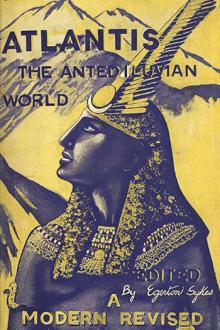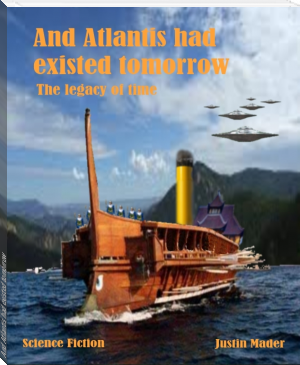Atlantis: The Antedeluvian World by Ignatius Donnelly (thriller novels to read .TXT) 📕

- Author: Ignatius Donnelly
- Performer: -
Book online «Atlantis: The Antedeluvian World by Ignatius Donnelly (thriller novels to read .TXT) 📕». Author Ignatius Donnelly
The following rude cut, from Cosmos, represents the high mountain in the north behind which the sun hid himself at night, thus producing the alternations of day and night. His solar majesty is just getting behind the mountain, while Luna looks calmly on at the operation. The mountain is as crooked as Culhuacan, the crooked mountain of Atzlan described by the Aztecs.
THE MOUNTAIN THE SUN GOES BEHIND AT NIGHTCHAPTER V
THE DELUGE LEGENDS OF AMERICA.
“It is a very remarkable fact,” says Alfred Maury, “that we find in America traditions of the Deluge coming infinitely nearer to that of the Bible and the Chaldean religion than among any people of the Old World.
It is difficult to suppose that the emigration that certainly took place from Asia into North America by the Kourile and Aleutian Islands, and still does so in our day, should have brought in these memories, since no trace is found of them among those Mongol or Siberian populations which were fused with the natives of the New World. . . . The attempts that have been made to trace the origin of Mexican civilization to Asia have not as vet led to any sufficiently conclusive facts. Besides, had Buddhism, which we doubt, made its way into America, it could not have introduced a myth not found in its own scriptures. The cause of these similarities between the diluvian traditions of the nations of the New World and that of the Bible remains therefore unexplained.”
The cause of these similarities can be easily explained: the legends of the Flood did not pass into America by way of the Aleutian Islands, or through the Buddhists of Asia, but were derived from an actual knowledge of Atlantis possessed by the people of America.
Atlantis and the western continent had from an immemorial age held intercourse with each other: the great nations of America were simply colonies from Atlantis, sharing in its civilization, language, religion, and blood. From Mexico to the peninsula of Yucatan, from the shores of Brazil to the heights of Bolivia and Peru, from the Gulf of Mexico to the head-waters of the Mississippi River, the colonies of Atlantis extended; and therefore it is not strange to find, as Alfred Maury says, American traditions of the Deluge coming nearer to that of the Bible and the Chaldean record than those of any people of the Old World.
“The most important among the American traditions are the Mexican, for they appear to have been definitively fixed by symbolic and mnemonic paintings before any contact with Europeans. According to these documents, the Noah of the Mexican cataclysm was Coxcox, called by certain peoples Teocipactli or Tezpi. He had saved himself, together with his wife Xochiquetzal, in a bark, or, according to other traditions, on a raft made of cypress-wood (Cupressus disticha).
Paintings retracing the deluge of Coxcox have been discovered among the Aztecs, Miztecs, Zapotecs, Tlascaltecs, and Mechoacaneses. The tradition of the latter is still more strikingly in conformity with the story as we have it in Genesis, and in Chaldean sources. It tells how Tezpi embarked in a spacious vessel with his wife, his children, and several animals, and grain, whose preservation was essential to the subsistence of the human race. When the great god Tezcatlipoca decreed that the waters should retire, Tezpi sent a vulture from the bark. The bird, feeding on the carcasses with which the earth was laden, did not return.
Tezpi sent out other birds, of which the humming-bird only came back with a leafy branch in its beak. Then Tezpi, seeing that the country began to vegetate, left his bark on the mountain of Colhuacan.
“The document, however, that gives the most valuable information,” says Lenormant, “as to the cosmogony of the Mexicans is one known as ‘Codex Vaticanus,’ from the library where it is preserved. It consists of four symbolic pictures, representing the four ages of the world preceding the actual one. They were copied at Chobula from a manuscript anterior to the conquest, and accompanied by the explanatory commentary of Pedro de los Rios, a Dominican monk, who, in 1566, less than fifty years after the arrival of Cortez, devoted himself to the research of indigenous traditions as being necessary to his missionary work.”
There were, according to this document, four ages of the world. The first was an age of giants (the great mammalia?) who were destroyed by famine; the second age ended in a conflagration; the third age was an age of monkeys.
“Then comes the fourth age, Atonatiuh, ‘Sun of Water,’ whose number is 10 X 400 + 8, or 4008. It ends by a great inundation, a veritable deluge. All mankind are changed into fish, with the exception of one man and his wife, who save themselves in a bark made of the trunk of a cypress-tree. The picture represents Matlalcueye, goddess of waters, and consort of Tlaloc, god of rain, as darting down toward earth. Coxcox and Xochiquetzal, the two human beings preserved, are seen seated on a tree-trunk and floating in the midst of the waters. This flood is represented as the last cataclysm that devastates the earth.”
The learned Abbé Brasseur de Bourbourg translates from the Aztec language of the “Codex Chimalpopoca” the following Flood legend: “This is the sun called Nahui-atl, ‘4 water.’ Now the water was tranquil for forty years, plus twelve, and men lived for the third and fourth times. When the sun Nahui-atl came there had passed away four hundred years, plus two ages, plus seventy-six years. Then all mankind was lost and drowned, and found themselves changed into fish. The sky came nearer the water. In a single day all was lost, and the day Nahui-xochitl, ‘4
flower,’ destroyed all our flesh.
“And that year was that of cé-calli, ‘1 house,’ and the day Nahui-atl all was lost. Even the mountains sunk into the water, and the water remained tranquil for fifty-two springs.
“Now at the end of the year the god Titlacahuan had warned Nata and his spouse Nena, saying, ‘Make no more wine of Agave, but begin to hollow out a great cypress, and you will enter into it when in the month Tozontli the water approaches the sky.’
“Then they entered in, and when the god had closed the door, he said, ‘Thou shalt eat but one ear of maize, and thy wife one also.’
“But as soon as they had finished they went out, and the water remained calm, for the wood no longer moved, and, on opening it, they began to see fish.
“Then they lit a fire, by rubbing together pieces of wood, and they roasted fish.
“The gods Citlallinicué and Citlalatonac, instantly looking down said: ‘Divine Lord, what is that fire that is making there? Why do they thus smoke the sky?’ At once Titlacahuan-Tezcatlipoca descended. He began to chide, saying, ‘Who has made this fire here?’ And, seizing hold of the fish, he shaped their loins and heads, and they were transformed into dogs (chichime).”
Here we note a remarkable approximation to Plato’s account of the destruction of Atlantis. “In one day and one fatal night,” says Plato, “there came mighty earthquakes and inundations that ingulfed that warlike people.” “In a single day all was lost,” says the Aztec legend.
And, instead of a rainfall of forty days and forty nights, as represented in the Bible, here we see “in a single day. . . even the mountains sunk into the water;” not only the land on which the people dwelt who were turned into fish, but the very mountains of that land sunk into the water. Does not this describe the fate of Atlantis? In the Chaldean legend “the great goddess Ishtar wailed like a child,” saying, “I am the mother who gave birth to men, and, like to the race of fishes, they are filling the sea.”
In the account in Genesis, Noah “builded an altar unto the Lord, and took of every clean beast, and of every clean fowl, and offered burnt offerings on the altar. And the Lord smelled a sweet savor; and the Lord said in his heart, ‘I will not again curse the ground any more for man’s sake.’” In the Chaldean legend we are told that Khasisatra also offered a sacrifice, a burnt offering, “and the gods assembled like flies above the master of the sacrifice.” But Bel came in a high state of indignation, just as the Aztec god did, and was about to finish the work of the Deluge, when the great god Ea took ‘‘pity in his heart and interfered to save the remnant of mankind.
These resemblances cannot be accidental; neither can they be the interpolations of Christian missionaries, for it will be observed the Aztec legends differ from the Bible in points where they resemble on the one hand Plato’s record, and on the other the Chaldean legend.
The name of the hero of the Aztec story, Nata, pronounced with the broad sound of the a, is not far from the name of Noah or Noe. The Deluge of Genesis is a Phœnician, Semitic, or Hebraic legend, and yet, strange to say, the name of Noah, which occurs in it, bears no appropriate meaning in those tongues, but is derived from Aryan sources; its fundamental root is Na, to which in all the Aryan language is attached the meaning of water—{Greek} na’ein, to flow; {Greek} na~ma, water; Nympha, Neptunus, water deities. (Lenormant and Chevallier, “Anc. Hist. of the East,” vol. i., p. 15.) We find the root Na repeated in the name of this Central American Noah, Na-ta, and probably in the word “Na-hui-atl”—the age of water.
But still more striking analogies exist between the Chaldean legend and the story of the Deluge as told in the “Popul Vuh” (the Sacred Book) of the Central Americans:
“Then the waters were agitated by the will of the Heart of Heaven (Hurakan), and a great inundation came upon the heads of these creatures. . . . They were ingulfed, and a resinous thickness descended from heaven; . . . the face of the earth was obscured, and a heavy darkening rain commenced-rain by day and rain by night. . . . There was beard a great noise above their heads, as if produced by fire. Then were men seen running, pushing each other, filled with despair; they wished to climb upon their houses, and the houses, tumbling down, fell to the ground; they wished to climb upon the trees, and the trees shook them off; they wished to enter into the grottoes (eaves), and the grottoes closed themselves before them. . . . Water and fire contributed to the universal ruin at the time of the last great cataclysm which preceded the fourth creation.”
Observe the similarities here to the Chaldean legend. There is the same graphic description of a terrible event. The “black cloud” is referred to in both instances; also the dreadful noises. the rising water, the earthquake rocking the trees, overthrowing the houses, and crushing even the mountain caverns; “the men running and pushing each other, filled with despair,” says the “Popul Vuh;” “the brother no longer saw his brother,” says the Assyrian legend.
And here I may note that this word hurakan—the spirit of the abyss, the god of storm, the hurricane—is very suggestive, and testifies to an early intercourse between the opposite shores of the Atlantic. We find in Spanish the word huracan; in Portuguese, furacan; in French, ouragan; in German, Danish, and Swedish, orcan—all of them signifying a storm; while in Latin furo, or furio, means to rage. And are not the





Comments (0)